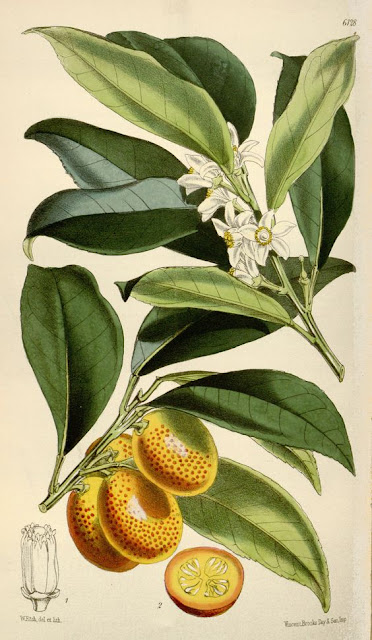I wish you a Merry Christmas and a Happy New Year, Dear Reader!
Monday 24 December 2018
Tuesday 18 December 2018
Noël! Noël! 2018
It's feeling a little bit German around here this Festive Season. No, not like the illustration above; it is, after all, a topsy-turvy world here in the Antipodes. It has been distinctly stormy and steamy this week (or sultry, as my Italian father-in-law was wont to say), as we run headlong toward the Summer Solstice. We've even had some Dramatic Wind to contend with around the Pipistrello roost and the emergency services came to salvage a neighbour's crushed car from under half a decades-old Ficus rubiginosa that had split down its middle in our driveway, but I digress...
I had thought to put paid to the ghastly, commercial, boxed Italian Panettone by baking my own this year (I do have plenty of candied citrus peel to get through) but have been distracted by a recipe for Stollen with a great hunk of marzipan through the middle (and thank you, Clever L for pointing out that they are to be found aplenty at Aldi, but That's Not The Point). It's not something I've ever eaten but it sounds delicious and the picture looks amazing. There are no longer 3 weeks left to have it Mature if I make it today but who's to know the difference? There are no connoisseurs of German baking around here. Not that that stops me from mucking around with new things. I can say now that after a few variations, Lebkuchen is not on my Greatest Hits list and won't be revisited again but Bethmännchen is a keeper and Pfeffernüsse is on my list for today. Yes, I shall be whipping up my own marzipan and Lebkuchengewürz before dazzling myself with some new hausfrau skills. I am optimistic! I'm loving my new German vocabulary, too.
 |
| This'll be Pipistrello later today |
These past years, we've musically launched ourselves into Christmas by taking in some olde worlde carols with a group of friends at the concert which rounds out the Australian Brandenburg Orchestra and Choir's season. We regrettably missed 2017, so Mr. P and I were determined not to miss the Noël! Noël! Baroque-fest this year. Off we trundled, our little group of carol faithfuls this year limited to just us and J&P, to the acoustically atmospheric St. Francis of Assisi church in Paddington, our expectations high. And we were not disappointed!
 |
| Not Paul Dyer! |
 |
| Hildegard working hard |
 |
| Johann Crüger's Lutheran chorale |
We heard a range of pieces, from Gregorian chant to Irish lullaby, instrumental arrangements of crowd-pleasing carols like We three kings of Orient are, and vocal arrangements of the likes of White Christmas. A stunning piece by contemporary choral composer Ēriks Ešenvalds, Only in sleep, with its shimmering cymbals was as traditional and carol-y as Johannes Eccard's early Baroque polyphonic work, Ich steh an deiner Krippen hier.
 |
| Like the Brandenburg, dressed by the C16th M.J. Bale |
George Frideric Handel's colourful Baroque aria, 'Let the bright seraphim' from Samson, was a terrific showcase for Bonnie's voice (now cutting an elegant figure in a white Grecian-esque gown) and the Baroque trumpet talents of Leanne Sullivan. Like the magic of agrodolce, what sounds on paper to be a very unhappy pairing makes for an exquisite surprise!
 |
| Not Leanne Sullivan! |
Saturday 1 December 2018
Citrus Redux
 |
| Citrus Bounty, circa 1620 Jacob van Hulsdonck |
No complaints from me, however (and not just because the mangoes and melons and stone fruit of summer are filling the void and Look!, cherries!), because during those times of plenty, Pipistrello went all out for Preserving for a change.
Alongside the lemony delicious things like syrup and frozen useful bits I shared earlier about these pages, I did add some candied lemon peel to the list, which is very nice with coffee. And a gift of limes were similarly treated, but I forgot to pare the rinds for candying, so that'll be for another time.
 |
| Fortunately, we love the Fortunella margarita |
For a twist on brandied kumquats, I made a batch with a bottle of Brazilian Cachaça, as it was what I had to hand. The resulting fruits are not quite as I expected, they're chewier and of a fire-breathing nature (and a different recipe will be employed next time), but we think that they will work skewered on a cocktail stick in a martini, so we could have a carefree Mad Men Party any old day now. The decanted sugar and Cachaça, too, is a rather interesting spirit now and when we are gripped by needing a caipirinha at said party, we are set, otherwise it's a potent drink to sip neat.
 |
| Breakfast at our place these days |
Off to the Greengrocery, I trundled, in search of some oranges and lo! Citrus x aurantium* (a.k.a. Seville oranges) aplenty were to be had! Armed then with these preciously rare, bitter oranges, I consulted Arabella Boxer's recipe, which boils up the fruit whole, and is thus a doddle to make. Twenty jars later, I made a Blue Ribbon-worthy first attempt at Seville Orange & Grapefruit Marmalade and Seville Orange & Ginger Marmalade (plus four jars of Framboise-scented Strawberry Jam, as I was on a roll!). While 24 jars of breakfast preserve seems like a lot for two people to get through, and it is!, it has been rapidly whittled down as they do make handy gifts and I was keen to get a broader Taste Test.
Verdict: I have a new feather to add to my cap: Marmaladière to Friends & Family!
* Back in the Olden Days when the Pipistrello's had a garden of their own, I did valiantly try growing Citrus × aurantium var. myrtifolia, a.k.a. the Chinotto orange, as I fancied trying my hand at making Chinotto. It all came to nought as the tree never flourished. Notwithstanding these failed experiments, next up on the list is an attempt to make my own Tonic Water, as G&T season is almost upon us. A few more citrus bits will be employed for that recipe, too.
Subscribe to:
Posts (Atom)

